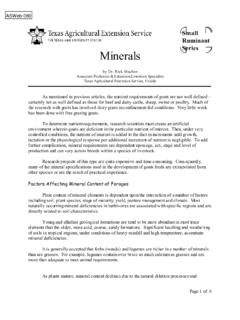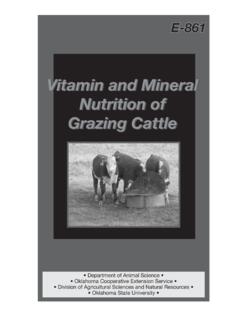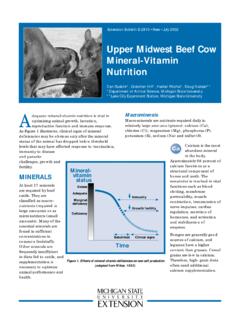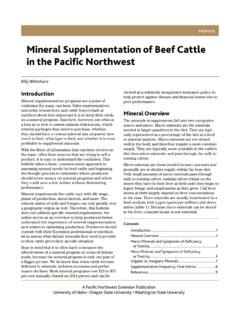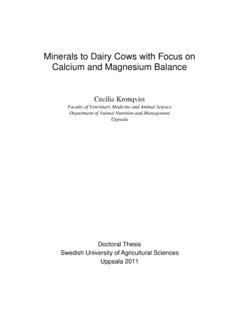Transcription of Mineral and Vitamin Supplementation of Beef Cows in ...
1 Agriculture and Natural Resources FSA3035 Mineral and Vitamin Supplementation of beef cows in Arkansas Shane Gadberry Introduction Extension livestock Specialist Cattle require the proper balance of water, energy, protein, vitamins and minerals to achieve optimal levels of production. In some cases all the necessary vitamins and minerals are present in the forage. However, it is not unusual for forage-based diets to be deficient in one or more minerals and Vitamin A. Because of this, a general understanding of Vitamin and Mineral nutrition is necessary to help guide Vitamin and Mineral Supplementation programs. Vitamins for the Cow Herd Since most water soluble vitamins are actively synthesized by the rumen microorganisms or in the tissues, Supplementation is normally not required. Exceptions to this are vitamins A and D (and sometimes E).
2 Because one or more may be deficient in specific situations, they are normally included together in supplements or injectable preparations. Vitamin A. Vitamin A is the Vitamin that is most likely to be deficient for beef cattle. When Vitamin A is deficient at the tissue level, problems can arise with impaired production and decreased integrity of epithelial tissues (skin and eyes). The deficiency shows up as decreased feed intake and daily gains, runny eyes, poor conception rates and increased susceptibility to diseases such as pinkeye. The Vitamin A precursor, beta-carotene, is found at high levels in growing or freshly-stored green forages, Arkansas Is but it is low in mature or drought-stricken Our Campus forage and hay that has been stored for prolonged periods. The liver can store large amounts of Vitamin A, and stores will generally last from two to four months Visit our web site at: following extended time grazing green forage.
3 Because of these factors, Vitamin A deficiency in Arkansas is most likely to occur during the latter portion of the wintering period (when animals have been fed stored hay for several months), or during an extended period of drought. Requirements for Vitamin A are 1270 IU/pound dry feed for pregnant beef heifers and cows and 1770 IU/pound dry feed for lactating cows . Supplemental Vitamin A can be given either in the diet or by injection. Vitamin A is often included in free-choice Mineral supplements. However, when added to Mineral supplements, Vitamin A can be destroyed by some minerals if the supplement is stored for long periods. Also, it may be provided during periods it is not needed. Vitamin A may also be included in protein/energy supplements. Because this type of supplement is likely to be fed to the beef herd during winter feeding or during times of drought, this is a good way to supplement.
4 Vitamin D. Vitamin D is found in sun-cured forages and is also synthesized in the skin of animals exposed to sunlight. If animals are kept in confinement where they have little exposure to sunlight, a deficiency might result. The deficiency would show up as stillborn calves, rickets in young animals, and bone weakness in older animals. Because it is unusual to confine beef cattle for extended times in Arkansas, Supplementation is not normally required. Vitamin E. Vitamin E is an antioxidant that prevents the formation of peroxides that can damage body tissues. Its function is related to that of selenium, which detoxifies peroxides once they are formed. White muscle disease in calves can result from Vitamin E deficiency, but it is more often due to a deficiency of selenium. Vitamin E is found in forages, but it may be destroyed during sun-curing and long-term storage.
5 Use of a Mineral supplement or an injectable preparation University of Arkansas, United States Department of Agriculture, and County Governments Cooperating containing vitamins A, D and E should provide enough of These factors and very low body magnesium stores can lead these vitamins to overcome any possible problems. to acute magnesium deficiency, a malady known as grass tetany. Supplementation with magnesium oxide is Minerals for the Cow Herd recommended for 30 days prior to calving and during the first three months of lactation. Cattle usually require some form of Mineral Supplementation during all times of the year. The required minerals are divided into major (macro) and trace (micro) minerals. Major minerals are reported as a percentage of the diet. The major minerals include sodium, chlorine, potassium, calcium, phosphorus, magnesium and sulfur.
6 Trace minerals are required at much lower levels than the major minerals but are just as essential. Trace minerals are commonly reported as parts per million (ppm). Required trace minerals include zinc, copper, selenium, manganese, iron, nickel, cobalt, molybdenum and iodine. Major Minerals Salt (sodium chloride). Supplemental salt is almost always required by the beef herd. The only exception is when water is very high in salt or with forages that are grown on very salty soils. Sodium and chlorine are major electrolytes found in body fluids, and there is very little storage. Because of this, cattle will develop deficiencies rapidly and should have constant access to salt or a supplement containing salt. Phosphorus. Phosphorus is often deficient in forages for lactating cows with superior milking ability. In addition, mature forages are often deficient in phosphorus for most cattle.
7 Phosphorus is high in oilseed meals (soybean and cottonseed meal) and also fairly high in grains; so when diets contain substantial amounts of these ingredients, Supplementation is usually not needed. Phosphorus is one of the structural components of the skeletal system, and levels build up when cows are grazing lush forages that contain phosphorus at levels above requirements. Some of the phosphorus in bone can be mobilized during early lactation to overcome shortfalls in intake, but prolonged dietary deficiency has been reported to result in depressed reproductive efficiency and milk production. Calcium. Calcium is usually not deficient in grass forages fed to beef cattle in Arkansas. In addition, legumes such as alfalfa and clover are high in calcium. Grains, by-product feeds and corn silage are low in calcium, and diets high in these feed ingredients will need to be supplemented, usually with feed grade limestone or calcium carbonate.
8 Like phosphorus, calcium is a structural part of bone, so temporary shortfalls in the diet can be overcome by the animal mobilizing some of the calcium in bone. When the diet contains added fat, such as when whole cottonseed is fed, the calcium requirement is increased. Calcium to phosphorus ratio is not as important for cattle as it is for other livestock , but situations where phosphorus is high relative to calcium may result in urinary calculi (stones). Calcium to phosphorus ratio should normally be maintained at a level between 1:1 and 5:1. Magnesium. Forages contain adequate magnesium during most of the year, but levels can be very low during times of rapid growth in the spring and fall, especially in well-fertilized pastures. There can also be high levels of potassium in forage at this time, which can interfere with the absorption of magnesium.
9 The low level of magnesium in forage often corresponds to calving seasons and the onset of lactation, which is when cow requirements are highest. Potassium. Potassium is usually excessive in most forages used in Arkansas with the exception of weathered stockpiled forages. Potassium is primarily present as an electrolyte in body fluids, so there is little storage. Despite this, situations where potassium Supplementation of the brood cow herd is needed are rare. Sulfur. Sulfur is a component of several amino acids that are the building blocks of protein. Sulfur, other than that fed in the form of protein, is usually needed only when diets contain substantial amounts of nonprotein nitrogen (NPN). In these situations, the ratio of nitrogen to sulfur should be maintained between 10:1 and 15:1. High sulfur levels can interact with copper and molybdenum, which can result in a copper deficiency.
10 Corn by-product feeds can be very high in sulfur. A neurological disorder (polioencephalomalacia) may result when cattle consume excessive quantities of these feeds, especially in the presence of other sources of sulfur such as water. Trace Minerals Zinc. Zinc is deficient in many Arkansas forages. Forty percent of hays tested at the U of A Agricultural Services Lab were deficient in zinc. This value does not factor in bioavailability. Zinc is a part of many important enzyme systems in the body, and its deficiency leads to depressed feed intake and growth rate, an abnormal hair coat and skin lesions. Zinc is important in male reproduction. An adequate zinc status is also needed for normal immune response. Storage of zinc is minimal, and deficiencies occur rapidly following introduction of animals to a diet severely deficient in zinc. Zinc methionine, an organic form of zinc, has improved performance in feedlot cattle and in cattle grazing forages already containing adequate levels of zinc.


